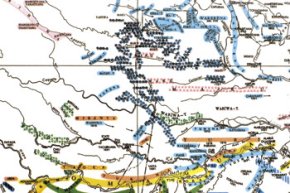 Ethnic-Historic Map from Curt Nimuendaju (IBGE)In December of 1944, bent over an enormous sheet of paper, the German naturalized Brazilian, Curt Nimuendaju put his final touches to a map, patiently traced out over a four month period in Indian ink. It was not just another piece of work, but the Ethnic-Historic Map with thousands of symbols, colors and names representing 1,400 groups of Indians. Unprecedented, the enterprise brought on a 2 by 2 meter square space the first major synthesis of ethnological knowledge available until that year, a good part of it gathered personally. It brought information about locality, linguistic affiliation and the migration movements of extinct and existing tribes in Brazil.
Ethnic-Historic Map from Curt Nimuendaju (IBGE)In December of 1944, bent over an enormous sheet of paper, the German naturalized Brazilian, Curt Nimuendaju put his final touches to a map, patiently traced out over a four month period in Indian ink. It was not just another piece of work, but the Ethnic-Historic Map with thousands of symbols, colors and names representing 1,400 groups of Indians. Unprecedented, the enterprise brought on a 2 by 2 meter square space the first major synthesis of ethnological knowledge available until that year, a good part of it gathered personally. It brought information about locality, linguistic affiliation and the migration movements of extinct and existing tribes in Brazil.
This was the third example of the same map manufactured by him, this time for the National Museum of Rio de Janeiro. The other two had been made for the Emílio Goeldi Museum in Para State (1943) and for the Smithsonian Institution (1942). A detail: one was not a mere copy of another. With each new map the number of pieces of data and the bibliography used, grew. The final one came accompanied with three indices, namely: bibliography, (with more than 950 indications), tribes and authors.
Curt Nimuendaju (1883-1945) is a fundamental figure in Brazilian ethnography and ethnology. “His Ethnic-Historic Map is a historic cartographic accomplishment of enormous scope and a precious document”, attests the anthropologist Eduardo Viveiros de Castro, from the National Museum of the Federal University of Rio de Janeiro, author of A inconstância da alma selvagem, e outros ensaios de antropologia [The inconstancy of the savage soul, and other anthropology essays] (Publisher: Cosac & Naify, 2002). “Nimuendaju was a great ethnologist and the person who most entered into contact and lived among the Indians”, says Luís Donisete Benzi Grupioni, an anthropologist from the University of Sao Paulo and author of Coleções e expedições vigiadas [Collections and watched over expeditions] (Publisher: Hucitec/Anpocs, 1998).
The map was his last major work – he died in 1945 among the Ticuna Indians, in a manner never quite clarified. At the beginning of his work with the Indians, Nimuendaju first collected artifacts from Brazilian tribes to make up the museum collections in Gothenburg, Hamburg, Leipzig and Dresden, in Europe, and for the São Paulo, National and Goeldi museums in Brazil. In his second phase, he became a true researcher, writing down sociological notes about indigenous groups that were used by Robert Lowie, from the University of California, with the due citation. Nimuendaju always published articles and monographies about the life style and languages used by the many groups with whom he lived. “As he almost always wrote in German, there are still text unpublished in Portuguese”, says Grupioni.
His story is even more surprising when one considers that he only studied until high school and never frequented a university. A native of Jena, near the city of Thuringia, at sixteen years of age he went to learn optical mechanics at the company Zeiss, where he was a regular frequenter of the factory’s library. There he liked to read about South America and to study its maps. He came to São Paulo in 1903 and two years later, still when he called himself, Curt Unkel, he penetrated into the São Paulo woodlands, contracted as a kitchen helper for the Geography and Geology Commission of São Paulo.
The objective was to explore the Aguapeí river and to make contact with the Guarani and Caingangue Indians in the west of Sao Paulo State. At 22 years of age, the young man was completely seduced by those primitive civilizations. A year afterwards he went on to live with the Apapokuva-Guarani and received from them the name Nimuendaju – “the one who creates or makes his own home”. His identification with the Indians was so great that it led him to always adopt his name, including his signature on all of the texts that he wrote.
Republish